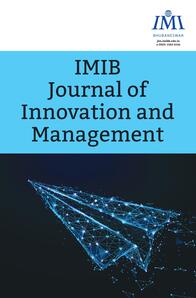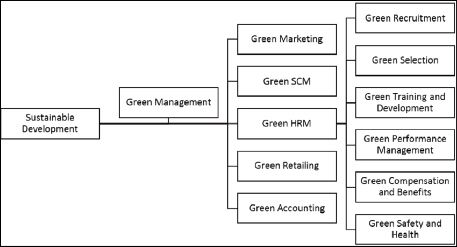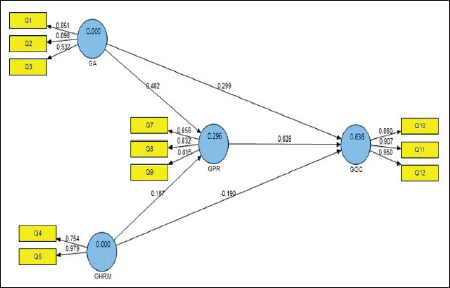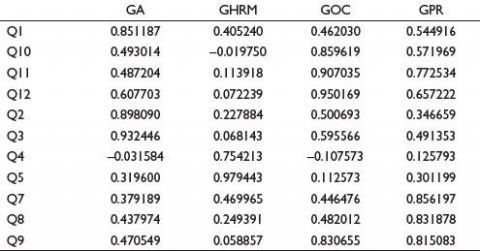
1 Department of Commerce, University School of Business, Chandigarh University, Mohali, Punjab, India
2 Department of Commerce, Mahatama Gandhi Kashi Vidyapith, Varanasi, Uttar Pradesh, India
Creative Commons Non Commercial CC BY-NC: This article is distributed under the terms of the Creative Commons Attribution-NonCommercial 4.0 License (http://www.creativecommons.org/licenses/by-nc/4.0/) which permits non-Commercial use, reproduction and distribution of the work without further permission provided the original work is attributed.
Companies now have been more aware of the increasing necessity of integrating environmental and human resources management practices. Green human resource management (GHRM) uses human resource management (HRM) strategies to foster sustainable resource usage in corporate organisations and advances the issues of environmental sustainability through disruptive technologies. To foster the implementation of GHRM uniformly throughout industries across the world could only reflect the marginal impact on environmental sustainability. The purpose of the research article is to identify whether the adoption of GHRM in the organisation brought behavioural change among employees towards organisational commitment that could lead environmental sustainability. The study is conducted amongst different public and private sector banks in the Varanasi district of Uttar Pradesh, India, through primary data collection of 330 respondents. For analysing the adoptability of green behaviour amongst employees in the organisation, we have adopted structural equation modelling to examine the employee’s commitment. The test result of the above tool of studying the four different latent variables leads us to conclude that path analysis and load factor exhibited stronger relationship through post-moderating effect, that is, latent variables lead towards green commitment. This leads us to conclude that organisations are trying to get environmental sustainability through GHRM practices, which in turn gives them a status of an environmentally sensitive organisation as well as some edge in this competitive environment. As a policy government is also expecting from organisations to develop themselves as environmentally sensitive by providing impetus of employee’s commitment.
GHRM, disruptive technology, environmental sustainability, human resource management, PLS-SEM
Introduction
An endless display of new technology is emerging in many parts. Almost all kinds of advancements are considered as progress, and the list of ‘next big things’ is growing exponentially. Not all emerging technologies will change the business or social environment—but some have the potential to disrupt the existing environment, change the way people live and work, and redesign pools of value. It is, therefore, important that business leaders and policy makers understand what technology will help them and prepare them accordingly. Automation and the digital economy that will transform lives, business, and the global economy, which could drive major economic change and disruption in the coming years. Disruptive technologies can change our world, as well as its benefits and challenges, and provide guidelines to help leaders from business and other institutions respond to mobilize traditional drivers of growth.
Green human resource management (GHRM) applies techniques for managing human resources (HR) to support a sustainable use of the resources of business organisations and to promote environmental sustainability more broadly (Mandip, 2015). The objective of environmental greening is to make use of environmentally responsible products and practices (without damaging or depleting resources to damage the environment) (Robinson, 2008). The GHRM, therefore, implies environmentally responsible HR policies and practices which, on the one hand, help organisations, through environmental brand identity, achieve their money objectives and, on the other hand, protect the environment against any adverse effects that can be caused by the policies and actions of their organisations. The capacity to satisfy the present demands without jeopardising the capability of forthcoming generations to meet their own needs and requirements is a concern of all environmentalists (WCED, 1987) and Cohen et al. (2012). There were many definitions provided in the environmental literature which generally showed the need for a balance between industrial development and the protection of the environment so that future generations may flourish (Daily & Huang, 2001). However, it is still disputed and unclear from the green movement for HR whether an individual organisation or society in general is achieving towards environmental sustainability? It is, therefore, important to study how firms may organise their facilities with GHRM to enhance sustainable growth. Maraget Mead’s quote from brainyquote https://www.brainyquote.com/quotes/margaret_mead_157496 rightly warns, ‘If we destroy environment, we have no civilisation’. This comment properly emphasises that our environment provides, both socially and business-wise, dangers and perspectives, and so everyone should be responsible for desperate love and attention towards environmental well-being and sacrifice to promote its health. Decision-makers should, thus, consider this while taking decisions.
The adoption of GHRM links human resource and environment policies (Sinniah et al., 2020) that promotes ethical management and broader support in the organisation’s sustainability. We have to safeguard our environmental resources for the next generations to flourish. The green concept for human resources management (HRM) aims to help us understand and maintain the natural environment and the need to balance industrial growth in order to create profit and prosperity. GHRM applications have become essential to environmentally friendly practices, conservation of knowledge capital, implementation of global initiatives and programmes that imperatively influence the business of companies through technical soundness, good government, and influence among employees and top managers. The delivery of GHRM activities should benefit from training programmes aimed to enhance employee environmental awareness. The training should focus on the creation of the green project and the promotion of innovation in environmental performance. The performance evaluation should be designed to best encourage the usage of GHRM adequately and fairly (Lülfs & Hahn, 2013).
Notwithstanding the increasing interest and possible industrial advantages of environmental management studies, few academicians have investigated the history of employees’ pro-environmental behaviour (Zibarras & Coan, 2015). The frequency of environmental deterioration and the rising shortage of resources have considerably expanded over the past few decades. Global anti-organisations have become increasingly active (Zsóka et al., 2013). To achieve the goal of GHRM which depends on employee’s commitment towards Employees Green Behaviour (EGB) in the organization.
It is important to stimulate employees pro-environmental behaviour level (Robertson & Barling, 2013; Vicente-Molina et al., 2013). As a result, proactive behavior toward environmental protection at the individual level, and employees have the freedom to adopt work passion with strong positive emotions (Blok et al., 2015; Norton et al., 2015).
Theoretical Background
Figure 1 best describes the theoretical background in support of the GHRM process.
Figure 1. Green HR Process.

Green Hiring (Recruitment and Selection)
After the first screening of curriculum vitae (CVs), HR managers may make sure in the successive stages of the selection process that the appropriateness of newcomers for green practice is examined. A simple matter of changes to the surroundings during a meeting or dynamic group combining a business case with challenges in maintainability are two easy techniques to identify someone’s biological awareness level. Finally, the green score for each contestant is to be given that finally ranks to fill the vacancy.
Green Performance
Performance measurement (PM) is a cycle that encourages employees to increase their professional capacity to better meet the organisation’s hierarchical aims and objectives. As a consequence, the frameworks for performance assessment may contain management objectives for the creation of a greener organisation.
Although it is simple to perform in some positions, it is probably the most important barrier to the green performance appraisal to gauge and increase the knowledge about natural performance standards across various hierarchical divisions/units. In order to counter this, firms may start using global frameworks that help them collect data while also offering advice on how to handle it and acquire a statement, such as ISO 14001 or the Global Reporting Initiative.
Green Awareness
Green objectives, goals and performance appraisal (PA) duties of managers might include things such as creating green awareness in their groups and encouraging employees to participate in green business activities in the corporation.
Green Leadership
It can create and implement long-term initiatives better. As a result, wider activity will likely arise, such as promoting public action that supports long-term success, welfare and prosperity of all members of society.
Green Orientation
The induction programme for workers should be developed so as to integrate new employees into a green culture. The orientation session should emphasise companies’ attention to green concerns such as wellness programme, safety and the green work environment.
Green Compensation and Reward
One potential method to assist environmental initiatives within the company is green compensation and rewards. In line with a tactical approach to contemporary firms develop incentives and rewards to promote environmentally friendly initiatives taken on their part by their staff.
Green Employee Relations
Work connections are part of the HRM, in which excellent working interactions between employers and workers are built. As a result of the connection and productivity, employee motivation and morale are increased. Employee relationships fundamentally include employee participation and capacity building. It also helps avoid and solve workplace problems that might affect the workplace.
Literature Review
Since several decades, numerous environmental concerns have come up. The governments of different nations have instructed companies and organisations, along with their operations, to focus on an environmental management programme (Mukherjee et al., 2020). Environmental sustainability has created more concern for managers, governments, customers and managers. The HRM function takes part in continuing conversations and debates, in a fight among the stakeholders and in the problems and possibilities arising from the environmental concerns. The business domain sees the origin of GHRM in pursuit of environmentally sustainable company with the growing role of the HRM function (Mehta et al., 2015). Environmentally friendly policies should be enacted to make our planet a decent place to live in. Organisations can be public or private. If they are integrated into their activities, they can make important contributions to maintaining a greener environment (Zubair & Khan, 2019). GHRM initiatives to develop environmental awareness are substantiative to this objective and generate further knowledge gaps in this area. This study aims to explore green human resources management practices (GHRMP) based on academics’ theoretical as well as actual studies (Kim et al., 2017). The results of the review show that it is beyond the scope of companies to gain green skills and offer employees the opportunity to engage in organisational endeavour. Organisations, which may restrict their efficiency in attempts to enhance environmental management (EM), do not use the entire spectrum of GHRM practices (Renwick et al., 2013). The green and non-green work result was improved in particular by individual employees. In turn, the benefits of GHRM’s implementation at organisational level have been creating an environmentally sound organisational culture and work environment, increasing the efficiency of various resources, building a positive business image and enhancing economic viability. In this study, the literature on GHRM development and its advantages for organisations are broadly discussed (García-Machado et al., 2019).
Conceptual Framework
The notion of social identity provides the theoretical foundation for workers’ psychological responses to a company’s green initiatives. Individuals’ social identities have a huge effect on how they behave, feel and participate in business contexts. This study is based on the social identity theory to examine the consequences of GHRM, such as eco-friendly behaviour, intention to stay and employee organisational commitment.
The current study explores the association between pro-environmental behaviour, namely green awareness (GA), GHRM and green organisational commitment (GOC) with the addition of green performance and rewards (GPR) as mediator. The research model is constructed based on a review of literature (see Figure 2).
The null hypothesis used for the study is as follows:
Figure 2. Research Model.

H0 = GA, GHRM and GOC are mediated by GPR
Research Design
Data
The purpose of the research article is to identify whether the adoption of GHRM in the organisation brought behavioural changes among employees towards organisational commitment that could lead to environmental sustainability.
The study is done by conducting the survey method on banking employees where all HRM processes are administered through disruptive technologies to attain the organisational commitment. The organisational commitment is a necessary prerequisite for bringing an exhibit employee’s green behaviour for environmental consciousness. To fortify this objective, a survey is conducted that includes more than 300 employees from different public and private sector banks in the region of Varanasi. A total of 150 different branches of public and private sector banks were selected on the basis of the number of employees working in a particular branch. So, 500 questionnaires were circulated with statements to be responded on a 5-point Likert scale, and around 330 completed response sheets were collected yielding 66% of the response rate.
Methodology
For measuring the constructs mentioned in Table 1, their corresponding variables have been adopted in the survey. Responses to the above constructs and variables have been collected using a 5-point Likert scale, that is, 5 = to a great extent and 1 = not at all. On the other hand, considering loading factor above 0.70, all our resultant variable fit into the model.
Table 1. Constructs and Variables Used in the Study.

Note: GA = green awareness; GHRM = green human resource management; GOC = green organisational commitment; GPR = green performance and rewards.
Table 2. Measurement Models.

Note: * Must be higher than 0.7.
The partial least square structural equation model (PLS-SEM) is employed in the study. This kind of technique is usually put into non-normal data. Validity and reliability of the scales were checked by factor loadings, average variance extracted (AVE), composite reliability (CR) and alpha values.
Figure 3. Path Analysis of GA, GHRM, GPR and GOC.

Table 3. Cross Loadings.

Results
Table 2 represents the measurement model, showing the results of pro-environmental behaviour, GHRM, GPR and GOC. First order factor loadings are counted for more than 70%, CR must also be above 70%, AVE should be above 50% and Cronbach’s alpha should be above 70%.
From the perusal of Table 2, all constructs and variables were found to be non-significant except a variable under construct of GHRM. The Cronbach’s alpha under GHRM was found to be 0.611, which is less than 0.70 suggesting us to remove the variable to improve the result. The respective loading factor of GHRM is 0.58. After deleting the significant variable, the path analysis is presented in Figure 3.
Table 3 exhibits cross-loading correlation coefficient factors of all variables. According to the table, all correlation coefficients were found to positive, except for two.
There is no positive correlation between green team management and campaign task with GHRM activities. Further green recruitment and selection has no positive relation with green awareness and green organisation and commitment.
The result leads us to suggest that green practices are fully imbibed by the employees, so far, in the organisation.
Discussion and Conclusion
In the above analysis for GHRM, GA, GOC with mediating effect of GPR embed on environmental sustainability. We have collected cross-sectional data for conducting the study. We have used PLS-SEM 2 which is free available software to fortify the data analysis. Using the above results, we found that the Q6 where the loading factor was less than 0.7 exemplifies the cost involvement in GHRM is found to be significant and when similar treatment is done through correlation matrix of cross loadings exhilarate that there is need to motivate employees towards green campaign and knowledge dissemination.
Based on above discussions, mostly all variables under different constructs were found to be insignificant thereby mostly all hypotheses have been accepted. The study is conducted amongst different public and private sector banks in the Varanasi district of Uttar Pradesh, India, through primary data collection of 330 respondents. For analysing the adoptability of green behaviour among employees in the organisations, we have adopted structural equation modelling to examine the employee’s commitment. The test result of the above tool of studying the four different latent variables leads us to conclude that path analysis and load factor exhibited stronger relationship through post-moderating effect, that is, latent variables lead towards green commitment. This leads us to conclude that organisations are trying to get environmental sustainability through GHRM practices which in turn gives them a status of an environmentally sensitive organisation as well as gives them some edge in this competitive environment.
Implications
Organisations should internalise their values, assisting employees in comprehending how the purpose and values relate to their specific positions inside the business. This should help them to communicate more effectively, ensuring that communications represent the organisation’s image consistently and often. Recruitment and selection methods, as well as the remuneration system, should integrate messages that represent the organisation’s image regularly and often. GPR systems must resolve conflicts between practices and regulations in order to increase employee GOC. Organisations should foster an atmosphere conducive to development. It should incentivise workers to take on more duties consistent with their skills. The disruptive technologies are proving itself as a remedial measure to go green using less paperwork. In future also, many such changes will be inevitably important for one and all to adopt the frequent change. As a policy, government is also expecting from organisations to develop themselves as environmentally sensitive by providing impetus of employee’s commitment. The research is intended to assist companies in gaining a better understanding of how to change conventional HRM practices into sustainable ones in order to maximise the benefits of GOC.
Limitations
Despite the fact that this research followed highly valid and trustworthy methodological and statistical processes, it, like all other studies, had certain statistical limitations. While the researchers have reasonable and enough literature support for all the procedures utilised in this analysis, each of these statistical tools is relatively sample size dependent. This indicates that with a larger sample size, outcomes are more likely to differ. First, as a consequence, a larger sample size may have shown entirely different outcomes than those reported in this research, impairing the accuracy and validity of the findings. Second, owing to time and cost restrictions, the research gathered data solely from Uttar Pradesh. Extending the research to various states of India might improve the study’s generalisability. Additionally, the study sample for this survey was limited to 330 respondents. To get a much broader and a more precise view on the area, a bigger sample size may be beneficial. Because the research employed a standardised scale with certain changes, it is possible that other HRM elements impact workers’ GOC.
Directions for Future Research
Similar research, using a case study technique, might be undertaken in banks. Comparative analysis among banks on the same subject may be an intriguing avenue for future research. Additionally, there are possibilities of comparative research between the two areas or on a greater scale by incorporating other states and conducting research on the enhancement of GOC before and after the adoption of GHRM.
Acknowledgements
This research article entitled ‘Economic Aspect of Implementing Green HR Practices for Environmental Sustainability’ is incomplete without putting forward the exceptional encouragement provided by the Department and the colleagues. This work is carried along with research scholar who is working on GHRM had provided me with his research data and further assistance and rest the article is the outcome of our combined work.
Declaration of Conflicting Interests
The authors declared no potential conflicts of interest with respect to the research, authorship and/or publication of this article.
Funding
The authors received no financial support for the research, authorship and/or publication of this article.
Blok, V., Wesselink, R., Studynka, O., & Kemp, R. (2015). Encouraging sustainability in the workplace: A survey on the pro-environmental behaviour of university employees. Journal of Cleaner Production, 106, 55–67. https://doi.org/10.1016/j.jclepro.2014.07.063
Cohen, E., Taylor, S., & Muller-Camen, M. (2012). HRM’s role in corporate social and environmental sustainability [Research report]. Society of Human Resources Management. https://www.shrm.org/hr-today/trends-and-forecasting/special-reports-and-expert-views/Documents/Corporate-Social-Environmental-Sustainability.pdf
Daily, B. F., & Huang, S. (2001). Achieving sustainability through attention to human resource factors in environmental management. International Journal of Operations and Production Management, 21(12), 1539–1552. https://doi.org/10.1108/01443570110410892
García-Machado, J. J., & Martínez-Ávila, M. (2019). Environmental performance and green culture: The mediating effect of green innovation—An Application to the Automotive Industry. Sustainability, 11(18), 4874. https://doi.org/10.3390/su11184874
Kim, A., Kim, Y., Han, K., Jackson, S. E., & Ployhart, R. E. (2017). Multilevel influences on voluntary workplace green behavior: Individual differences, leader behavior, and coworker advocacy. Journal of Management [Advance online publication], 43(5), 1335–1358. https://doi.org/10.1177/0149206314547386
Lülfs, R., & Hahn, R. (2013). Corporate greening beyond formal programs, initiatives, and systems: A conceptual model for voluntary pro-environmental behavior of employees. European Management Review, 10(2), 83–98. https://doi.org/10.1111/emre.12008
Mandip, G. (2015). December the journal of Nepalese business studies. Green HRM—People management commitment to environmental sustainability. Research Journal of Recent Sciences, 9, 244–252.
Mehta, K., Chugan, P. K., Pawan Kumar, & Green, H. R. M. (June 2015). Pursuit of environmentally sustainable business. Universal Journal of Industrial and Business Management, 3(3), 74–81.
Mukherjee, S., Bhattacharjee, S., Paul, N., & Banerjee, U. (2020). Assessing green human resource management practices in higher educational institute. Test Engineering and Management, 82. https://papers.ssrn.com/sol3/papers.cfm?abstract_id=3546928
Norton, T. A., Parker, S. L., Zacher, H., & Ashkanasy, N. M. (2015). Employee green behavior: A theoretical framework, multilevel review, and future research agenda. Organization and Environment, 28(1), 103–125. https://doi.org/10.1177/1086026615575773
Renwick, D. W. S., Redman, T., & Maguire, S. (2013). Green HRM: A review and research agenda. International Journal of Management Reviews, 15(1), 1–14. https://doi.org/10.1111/j.1468-2370.2011.00328.x
Robertson, J. L., & Barling, J. (2013). Greening organizations through leaders’ influence on employees’ pro-environmental behaviors. Journal of Organizational Behavior, 34(2), 176–194. https://doi.org/10.1002/job.1820
Robinson, F. (2008). Going green: What does it really mean? http://ezinearticles.com/?Going-green!-What-does-it-really-mean?&kd=2267926
Vicente-Molina, M. A., Fernández-Sáinz, A., & Izagirre-Olaizola, J. (2013). Environmental knowledge and other variables affecting pro-environmental behaviour: Comparison of university students from emerging and advanced countries. Journal of Cleaner Production, 61, 130–138. https://doi.org/10.1016/j.jclepro.2013.05.015
WCED. (1987). Our common future. Oxford University Press.
Zibarras, L. D., & Coan, P. (2015). HRM practices used to promote pro-environmental behavior: A UK survey. International Journal of Human Resource Management, 26(16), 2121–2142. https://doi.org/10.1080/09585192.2014.972429
Zsóka, Á., Szerényi, Z. M., Széchy, A., & Kocsis, T. (2013). Greening due to environmental education? Environmental knowledge, attitudes, consumer behavior and everyday pro-environmental activities of Hungarian high school and university students. Journal of Cleaner Production, 48, 126–138. https://doi.org/10.1016/j.jclepro.2012.11.030
Zubair, S. S., & Khan, M. (2019). Sustainable development: The role of green HRM. International Journal of Research in Human Resource Management, 1(2), 1–6.